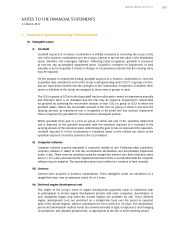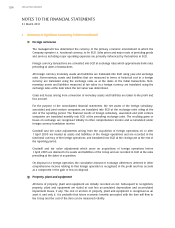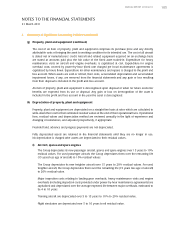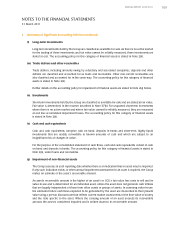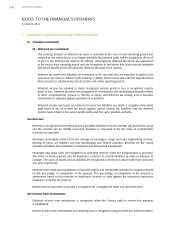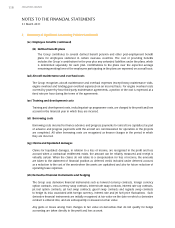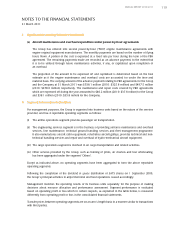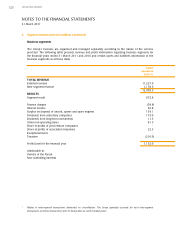Singapore Airlines 2011 Annual Report Download - page 112
Download and view the complete annual report
Please find page 112 of the 2011 Singapore Airlines annual report below. You can navigate through the pages in the report by either clicking on the pages listed below, or by using the keyword search tool below to find specific information within the annual report.SINGAPORE AIRLINES
110
NOTES TO THE FINANCIAL STATEMENTS
31 March 2011
2 Summary of Significant Accounting Policies (continued)
(p) Impairment of non-financial assets (continued)
For non-financial assets excluding goodwill and those with indefinite lives, an assessment is made at
each reporting date as to whether there is any indication that previously recognised impairment losses
may no longer exist or may have decreased. A previously recognised impairment loss is reversed only
if there has been a change in the estimates used to determine the asset’s recoverable amount since the
last impairment loss was recognised. If that is the case, the carrying amount of the asset is increased
to its recoverable amount. That increase cannot exceed the carrying amount that would have been
determined, net of depreciation, had no impairment loss been recognised previously. Such reversal is
recognised in the profit and loss account unless the asset is measured at revalued amount, in which
case the reversal is treated as a revaluation increase.
(q) Impairment of financial assets
The Group also assesses at the end of each reporting period whether a financial asset or a group of
financial assets is impaired.
(i) Assets carried at amortised cost
If there is objective evidence that an impairment loss on financial assets carried at amortised
cost has been incurred, the amount of the loss is measured as the difference between the asset’s
carrying amount and the present value of estimated future cash flows (excluding future credit
losses that have not been incurred) discounted at the financial asset’s original effective interest
rate. The carrying amount of the asset is reduced either directly or through the use of an allowance
account. The impairment loss is recognised in the profit and loss account.
When the asset becomes uncollectible, the carrying amount of the impaired financial asset is
reduced directly or if an amount was charged to the allowance account, the amounts charged to
the allowance account are written off against the carrying value of the financial asset.
To determine whether there is objective evidence that an impairment loss on financial assets has
been incurred, the Group considers factors such as the probability of insolvency or significant
financial difficulties of the debtor and default or significant delay in payments.
If, in a subsequent period, the amount of the impairment loss decreases and the decrease can
be related objectively to an event occurring after the impairment was recognised, the previously
recognised impairment is reversed to the extent that the carrying amount of the asset does not
exceed its amortised cost at the reversal date. The amount of reversal is recognised in the profit
and loss account.
(ii) Assets carried at cost
If there is objective evidence (such as significant adverse changes in the business environment
where the issuer operates, probability of insolvency or significant financial difficulties of the issuer)
that an impairment loss on financial assets carried at cost has been incurred, the amount of the
loss is measured as the difference between the asset’s carrying amount and the present value of
estimated future cash flows discounted at the current market rate of return for a similar financial
asset. Such impairment losses are not reversed in subsequent periods.





